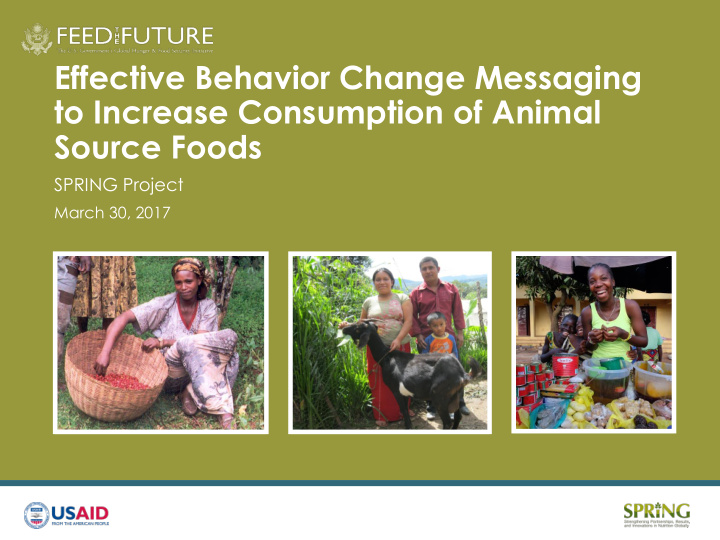



Effective Behavior Change Messaging to Increase Consumption of Animal Source Foods SPRING Project March 30, 2017
About SPRING Who we are What We Do • Strengthen global and country efforts to scale up high impact nutrition practices • Prevent stunting and anemia in the first 1,000 days • Link agriculture and nutrition under Feed the Future www.spring-nutrition.org
Why are we here? TOM MAGUIRE/RESULTS Weber, Lauren. 2016. “ Two Boys With The Same Birth Story Will Live Vastly Different Lives. ” The Huffington Post, June 29. www.spring-nutrition.org
What are the right messages to facilitate changes in practices? 1. What agriculture practices are most likely to contribute to nutrition in a given context? 2. How can we apply behavioral science to improve uptake of those practices? www.spring-nutrition.org
1. What agriculture practices are most likely to contribute to nutrition in a given context? Taking increasing household consumption of animal source foods as an example • Who are the farming, herding, and other market actors who influence household consumption of ASFs? • What are they already doing that contributes positively to household consumption of ASFs? Can that be amplified and scaled up? • What could they do differently within their core competencies and mission to contribute more to household consumption of ASFs? www.spring-nutrition.org
How does agriculture affect nutrition? Food consumed Farm income Gender in invested in… agriculture • calories • protein • diverse diet and maximizing • nutrient-rich foods women’s • micronutrients control of assets • health and WASH • safety and income services and products managing • demands of women’s time and energy www.spring-nutrition.org
2. How can we apply behavioral science to improve uptake of those practices? Taking increasing household consumption of animal source foods as an example • What are the risks and benefits to different market actors, including households, from current levels of hh consumption of ASFs? • What specific improved practice(s) will increase different actors’ contribution to household consumption of ASFs? • What are the risks and benefits involved in actors adopting the improved practice(s)? www.spring-nutrition.org
The COM-B model: Getting to action Reproduced from Michie, van Stralen, and West, 2011 www.spring-nutrition.org
The Socio-Ecological Model Source: Adapted from McKee, Manoncourt, Chin and Carnegie (2000) www.spring-nutrition.org
Planned and deliberate vs automatic and habitual behavior Automatic Conscious decisions and decisions and actions actions Driven by Driven by emotions and “rational” self- social approval interest Adverse to Maximize utility losses We have limited More prominent mental resources when we’re for this process tired or stressed www.spring-nutrition.org
Choice architecture: designing environments to engage our automatic brains Source: Slideshare presentation by Lola Sanchez www.spring-nutrition.org
What do the models mean for messages to increase consumption of animal source foods? • Promote ASFs in local terms — what do consumers value in food? • Link ASF consumption to short term risks and benefits • Messages should grab the heart and gut as well as the mind • Social identities and gender roles can enable or constrain acting on messages • Enabling environments move us to action www.spring-nutrition.org
Know Your Context • Relevant market actors and their influence on household consumption of ASFs? • Specific improved practices along value chains which contribute to increased hh consumption of ASFs? • Risks and benefits for households and other market actors of increased hh consumption of ASFs? • Social, market, physical, or policy barriers to action? www.spring-nutrition.org
Strengthen enablers for change: Facilitate availability, affordability and sustainability of diverse, nutritious foods • Impact on local markets is crucial • Avoid doing harm to the natural resource base: climate-smart ag! • Generating demand and improving supply together • Strengthen the enabling environment for food safety and quality www.spring-nutrition.org
Allow for some rapid experimentation to adapt change processes or practices to meet the needs of different actors: www.spring-nutrition.org
Getting to Messages: “Hero fathers” in Ethiopia • “A hero father makes sure his wife is getting extra cow milk daily while she’s exclusively breastfeeding to keep her feeling strong.” • “A hero father makes sure each day to leave enough money for his wife to purchase fruits and vegetables for the Photo credit: Kelley Lynch children because eating fruits and vegetables prevents illness.” www.spring-nutrition.org
Getting to Messages: joint decision- making about chickens in India • Community-produced videos show a local family: • discussing risks and benefits together • sharing tasks to improve practices • deciding together when to consume the meat/eggs at home, when to sell the Photo credit: Peggy Koniz-Booher meat/eggs, and how to use the income www.spring-nutrition.org
Coming Soon: Accelerating Behavior Change in Nutrition-Sensitive Agriculture www.spring-nutrition.org
Working Group • Criteria for prioritizing nutrition-sensitive agriculture practices during activity design • Research priorities Applying these criteria across a range of contexts and types • of market actors Evaluating efficacy and cost-effectiveness of interventions • which incorporate behavior change approaches • Scaling opportunities Integrating behavior change approaches and tools into • existing design processes and research/learning agendas Innovative partnerships with private sector firms • www.spring-nutrition.org
Working together means changing our own practices too. But it will pay off! www.spring-nutrition.org This presentation is made possible by the generous support of the American people through the United States Agency for International Development (USAID) and Feed the Future, the U.S. Government’s global hunger and food security initiative, under the terms of the Cooperative Agreement AID-OAA-A-11-00031 (SPRING), managed by JSI Research & Training Institute, Inc. (JSI). The contents are the responsibility of JSI and the authors, and do not necessarily reflect the views of USAID or the U.S. Government.
Recommend
More recommend